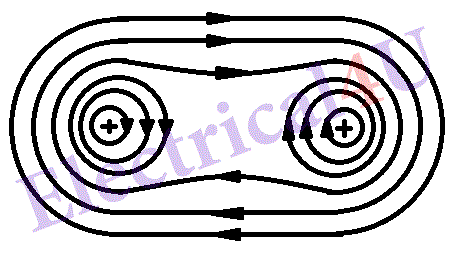If a compass is brought near a electric current carrying conductor, needle deflects which shows the presence of magnetic field around conductor. It has been observed that magnetic flux exists in circles around the conductor as shown in figure (c) and (d). The direction of current in the conductor and direction of field produced is have a definite relation. Figure (a) and (b) shows the conductor & direction of current in the conductors and field around them.



The direction of field with respect to the current in conductor can be remembered by the following rules
1. Right hand rule – Hold the conductor in right hand fingers closed and with thumb straight around the conductor as shown in fig (c) and with thumb pointing in the direction of current. The fingers will then point in the direction of magnetic lines of flux produced around the conductor.
2. Corkscrew rule – The corkscrew travel and the direction in which it has to be rotated are related to each other the same way as the direction of the current in a conductor and the direction of the field that would be produced due to the current. The magnetic field exists in plane perpendicular to the conductor.
If two parallel conductors carry current, they produced magnetic field around them depending on direction of the current in them. Figure (e) shows two parallel conductors carrying current in the same direction here inward and figure (f) shows two parallel conductors carrying current in opposite direction. It will be observed that the conductors carrying current in the same direction tends to drawn closer or attracts together while the conductors carrying current in opposite directions tend to be repelled from each other.


If the two parallel conductors carrying currents are separated by a distance r the force F exists between them which is given by—
F = 2 µµ0 I1 I2 l / 4πr newtons
Where I1 and I2 are currents in Ampere carried by the conductors respectively.
I = length of each parallel conductor in meters
r = distance of separation between the parallel conductors
µ = relative permeability of the medium
µ0 = permeability of free space = 4π x 10-7
This is experimental relation. This is also used to defied ampere in S.I. units, thus ampere is the current which when flowing in each of the two parallel conductors of infinite length of negligible cross section and separated with their centers one meter apart in vacuum, produced between the conductors a force of 2 x 10-7 newton per meter of their length.
Example:- Two parallel bus bars are separated by a distance of 10 cm between their centers. Find the force in newton per meter run between the busbars.
(a) when carrying direct current of 200A
&
(b) when carrying a short circuit current of 10,000A
Solution:-
(a) F = 2 µµ0 I1 I2 l / 4πr
= 2 x 1 x 4π x 10-7 x 200 x 200 x l/4π x 0.1
= 0.8 newton
(b) F = 2 µµ0 I1 I2 l / 4πr
= 2 x 1 x 4π x 10-7 x 104 x 104 x l/4π x 0.1
= 200 newton.
It will thus be observed that under short circuit conditions, a very large force is produced between the bus bars which is likely to wreck them from their clamps.
